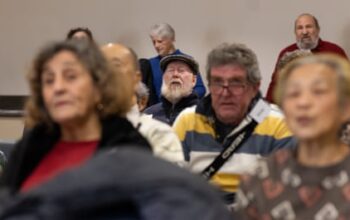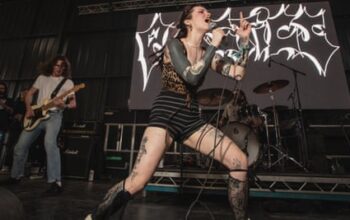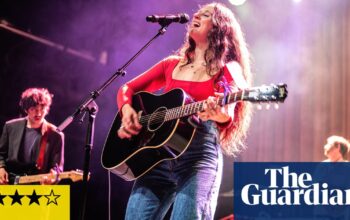F
Over the last four years, sightings of André 3000 have become almost like a legend. The typical scenario involves someone secretly recording the Outkast icon playing a wooden double flute in a public setting, causing a frenzy on social media. It’s akin to catching a glimpse of Pan, the Greek god of nature, lost in his own thoughts while playing at an outdoor yoga session in Philadelphia. He has also been spotted in various locations such as coffee shops, the streets of Tokyo, and airports around the world.
It’s probable that you’ll see André in Venice, California, where he lives on the west coast. On a Friday afternoon in late October, he can be found playing his cedarwood Mayan instrument near the organic cafes and high-end boutiques. Two camera operators are filming for a documentary about the making of his highly anticipated first solo album, New Blue Sun, which features instrumental music with celestial and meditative vibes. The patrons at the Michelin-recommended restaurant where he dines are thrilled.
André, speaking in a luxurious accent, compares his current situation to a game of Where’s Waldo. As he settles into his seat for our interview, he places his hand-carved Mesoamerican flute on a nearby ledge. He explains that people often recognize him playing his flute in various locations, such as the airport or Abbott Kinney Boulevard, and it can be overwhelming at times. Despite having a film crew with him today, he usually just wants to go to Starbucks and enjoy his hobbies of walking, hiking, and playing music without being noticed. He never stops exploring and pursuing his passions.

André Benjamin, who was born in Atlanta, is aware that it may seem strange. He would be in on the joke, except there is none. His five-year journey to become a master of the flute has resulted in eight tracks for his album New Blue Sun. These tracks were chosen from numerous recording sessions at Rick Rubin’s Shangri-La studio. André plays a digital woodwind, which he describes as a “weird wind-synth thing,” and is joined by some of Los Angeles’ top jazz and avant-garde musicians such as Carlos Niño, Nate Mercereau, Surya Botofasina, Matthewdavid, and VCR.
André’s journey into the world of jazz started with the influence of John Coltrane. While initially playing the saxophone, he eventually transitioned to Coltrane’s original instrument, the bass clarinet, and later picked up the flute. André explains, “There was a certain warmth and fluidity in the sound of woodwind instruments that resonated with me. It just felt like the perfect fit.”
This is one of the most revolutionary transformations in popular music history. The latest album, New Blue Sun, does not include any rap songs. The first track is called I Swear, I Really Wanted to Make a “Rap” Album But This Is Literally the Way the Wind Blew Me This Time. André speaks with sincere honesty, saying “I understand what will happen, but I am excited to share it with everyone.” He explains, “I had originally planned to make a rap album because I wanted to please my fans, but I would also love to silence the critics.” However, New Blue Sun captures a renewed sense of positivity and embodies the idea of not caring about others’ opinions, as André expressed 25 years ago on the Outkast track Liberation: “Now that’s liberation and, baby, I want it.”
As a child, I enjoyed drawing and painting and had aspirations of attending art school,” he explains. André is dressed in pinstriped overalls, which are loosely draped over a camouflage shirt. A dark blue beanie covers his greying hair. Despite being known for his fashion sense as a co-writer of “So Fresh, So Clean,” he is adorned with round caramel glasses, turquoise shell necklaces, and a thick gold bracelet – imagine Dizzy Gillespie if he were a surfer and into abstract expressionism. “When I first started rapping, I never imagined I would also become a producer or create the adventurous album, The Love Below,” he adds humbly. Despite winning seven Grammys (six with Outkast) and selling 20 million records, he remains grounded. “I am always curious to see where my journey takes me. I am also experiencing it as it unfolds. This new direction feels authentic and worth sharing. It’s the most genuine way for me to express myself.”
Y
It is impossible to overlook the anticipation surrounding a solo album from André. Rumors have surfaced intermittently since the last Outkast album in 2006 about studio collaborations with well-known producers. However, he chose to focus on his acting career, appearing in approximately twelve films and TV shows, including a biopic about Jimi Hendrix and the highly praised dramedy Showing Up last year. He also served as the spokesperson for Gillette, created and provided the voice for an Adult Swim cartoon called Class of 3000, and launched a short-lived fashion line inspired by the aesthetics of 1930s Ivy League football called Benjamin Bixby.
In 2013, a soundtrack for the Great Gatsby adaptation included a cover of Amy Winehouse’s Back to Black by André and Beyoncé. The following year, André and Big Boi reunited as Outkast and performed their popular songs at over 40 festivals. In 2018, two songs were released on SoundCloud featuring André on bass clarinet and James Blake on piano. He also made occasional guest appearances on successful albums by Drake, Frank Ocean, and Kanye West, delivering impressive rap verses.
André says that it was an enjoyable experience to collaborate on other artists’ songs. He believes that it is often simpler to join someone else’s event than to host your own. When the music scene and trends are evolving, there is not much you can do except find your place within it. These fellow artists helped keep him relevant, especially for younger listeners who may not be familiar with Outkast.

When it comes to his solo work, André felt limited by recognition and popularity. His stage name foreshadowed future success; anything less groundbreaking would have been seen as a disappointment. Outkast’s first four albums not only pioneered and defined southern hip-hop, but also pushed the boundaries of music itself. Outkast can be classified as their own unique genre, blending masterful rap storytelling with elements of soul, Afrofuturism, blues, rave, gospel, and funk. As creative differences caused a rift between them – with André leaning towards eclectic guitar-driven pop inspired by Prince and the Beatles, and Big Boi favoring a harder fusion of hip-hop and classic soul-funk – Outkast rose to become the top crossover rap group in history. Few albums have reached the widespread success of Speakerboxxx/The Love Below, which spawned the hit single Hey Ya!, performed by André in a bold electric-lime buckskin outfit at the 2004 Grammys. That night, Outkast won three awards, but never returned to the ceremony.
What actions do you take when you have achieved everything by the time you turn 30? According to André, as you age, honesty and beauty become more significant than anything else. You come to understand that you won’t be here forever, so the decisions you make are like: when I’m no longer around, what will I leave behind? “New Blue Sun” is a beautiful creation that holds more worth to me than rapping about my skills or praising a woman’s appearance. These are all human aspects, but I am striving to align with a specific set of values.
While this project may have come together easily, everything else has been far from simple. Following Outkast’s breakup, André has struggled with writer’s block, self-doubt, depression, social anxiety, and hypersensitivity disorders. On top of this, he also experienced the sudden deaths of both his parents within a short period of time – his mother in May 2013 and his father in February 2014. Finding a clear path forward has been challenging for a long time. “In order to stay inspired, you have to keep doing things that inspire you. I’m constantly searching for ways to keep moving forward,” he explains. “Sometimes, when you hit a roadblock, changing things up can help you reach that next level – like Picasso switching between sculpting and painting. I always try to do what brings me wonder.”
The server inquires if André desires any nourishment, yet he declines to request even a glass of water, citing that he has already consumed. His idiosyncrasies were satirized on the sketch comedy program Key & Peele, where André pranced into a café, dressed as a Swiss yodeler, and requested a “half-caff decaf mint mocha latte with foam on the bottom, served in a flower vase.” In this scenario, his moderation appears almost monk-like.
I met Niño, a respected member of LA’s experimental music community, by chance at a Venice grocery store, which led me on a journey to New Blue Sun. Niño, a composer, producer, and percussionist, invited me to a show that evening featuring the music of Alice Coltrane, whom I had been listening to all week. I saw this as a sign and attended the soundcheck, staying until the band finished and even taking photos with fans.
“He is extremely modest,” states Niño, who acted as the main contributor and unofficial producer for New Blue Sun. “He sees himself as a newcomer to all of this, despite being an inspiration to many of the musicians involved in the sessions. Although this may not be considered traditional hip-hop, it follows his style and incorporates the same elements of breath control, resourcefulness, experimentation, and originality.”
After the pandemic began, André visited Niño’s studio in Canoga Park twice for four-hour sessions with a trio and quartet. Six months later, André contacted Niño to express his interest in continuing in that direction after listening to their recordings nonstop. They then recorded numerous hours of music together. Niño invited talented musicians from the LA experimental scene to join in as well.

Even though he usually plays the wooden double flute, André decided to use a digital wind instrument on New Blue Sun. He had never used it before, but he found it exciting to try something new. He laughed and explained, “You’re listening to me play just 20 minutes after opening it out of the box. I’m still figuring out what I can do with it. It’s like discovering something new and watching a child play with bubbles for the first time.”
He is being modest. André may not have a formal education in music from Juilliard, but he possesses an indescribable natural talent that cannot be taught. As John Coltrane famously said, “You can play a shoestring if you’re sincere.” This is not just a personal project for him. His new album, New Blue Sun, is influenced by the likes of John and Alice Coltrane, Steve Reich, Philip Glass, Laraaji, and Yusef Lateef. The album features unique instruments such as gongs, three-stringed Moroccan lutes, and André’s own technique of “panther toning” on a track titled “That Night in Hawaii When I Turned Into a Panther and Started Making These Low Register Purring Tones That I Couldn’t Control… Sh¥t Was Wild.” This technique was inspired by an ayahuasca experience where he felt like he transformed into a panther and made involuntary noises. André believes that the psychedelic drug was playing him like a vibrating instrument and wishes he had recorded the experience.
He is aware that it may seem strange, but he has reached a state of Zen about the situation. “I had to come to terms with the fact that there may be resistance to this,” André explains. “But the joy I felt creating it – the passion I had for the music – was much stronger than any fear.”
The Outkast questions continue to linger, even though the duo never officially disbanded. As they pursued separate paths, their timeless music served as inspiration for the next generation of rap artists, such as Tyler, the Creator, Kendrick Lamar, and J Cole. Despite not collaborating as much, André and Big Boi maintain a close relationship. André describes it as “amazing” and mentions how Big Boi is supportive of his latest creative endeavors. They have a special chemistry that keeps their friendship strong, and André acknowledges that sometimes change is necessary to keep things exciting. They have been close friends since before they started rapping, and André cannot predict what the future holds for their partnership. He is open to whatever the journey may bring.
André starts his days by going on a five-mile walk. Then he goes to his creative studio in El Segundo to work on various artistic projects for his new company, A Myriad of Pyramids. He also takes video calls and sketches designs during this time. He spends the day playing the flute and is currently learning how to make the instrument through an apprenticeship. At night, he has recurring dreams, including one where he floats in the air, which he has had since the start of his career.
André expresses his constant amazement at his ability to fly without wings. He is eager to share this experience with his friends, but when he attempts to demonstrate it, it fails. The reason for this remains a mystery to him.
You don’t have to be a psychologist to recognise the aspirations of an artist caught between worlds: anxious to share their epiphanies, but worried that they won’t be understood. After all the years when gravity exerted its dreary force, you can finally glimpse André levitating again – so long as you are willing to listen closely, or lucky enough to catch him in the street.
Source: theguardian.com


